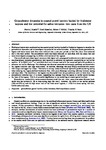Groundwater dynamics in coastal gravel barriers backed by freshwater lagoons and the potential for saline intrusion: Two cases from the UK
| dc.contributor.author | Austin, MJ | |
| dc.contributor.author | Masselink, Gerd | |
| dc.contributor.author | McCall, RT | |
| dc.contributor.author | Poate, Tim | |
| dc.date.accessioned | 2014-09-24T08:51:39Z | |
| dc.date.available | 2014-09-24T08:51:39Z | |
| dc.date.issued | 2013-08 | |
| dc.identifier.issn | 0924-7963 | |
| dc.identifier.issn | 1879-1573 | |
| dc.identifier.uri | http://hdl.handle.net/10026.1/3124 | |
| dc.description | “NOTICE: this is the author’s version of a work that was accepted for publication in Journal of Marine Systems. Changes resulting from the publishing process, such as peer review, editing, corrections, structural formatting, and other quality control mechanisms may not be reflected in this document. Changes may have been made to this work since it was submitted for publication. A definitive version was subsequently published in Journal of Marine Systems, [VOL 123, (01.08.13)] DOI 10.1016/j.jmarsys.2013.04.004". The full text is under embargo until 01.08.15. | |
| dc.description.abstract |
Field experiments were conducted on two coastal gravel barriers backed by freshwater lagoons to examine the groundwater dynamics and to investigate the potential for saline intrusion. At Slapton Sands, groundwater, lagoon and ocean water level data were collected over a one year period; at Low Bar, data were collected over a two week period. The groundwater table was highly dynamic at both sites, with the ocean tide and wave event signals propagating to within a few metres of the lagoons. The amplitude and phase lag of the ocean tidal signal as it propagated landwards were used to apply the one-dimensional unsteady groundwater flow equation to estimate the hydraulic conductivity of the barrier aquifers. K is O(0.01)ms-1 at both field sites, and this was used with the measured hydraulic gradients to estimate the barrier discharge. Net discharge was directed seawards and strongly positively correlated with the lagoon elevation and large wave events. In contrast, discharge was only weakly correlated with ocean tidal range and lagged by 4days. This is due to strong landward-directed hydraulic gradients during spring tides reducing the lagoon-derived freshwater flux, with peak discharge occurring mid-way between spring and neap tides. The shoreline of the lagoon was decoupled from the groundwater table at both sites. The groundwater elevation was 1-2m lower, suggesting that seepage from the lagoon to barrier occurs through the base of the lagoon. This is of potential significance to the modelling of coastal gravel barriers. Groundwater conductivity measurements demonstrated that salt water penetrates some distance landwards into the barriers (c. 60. m from spring high tide level). However, the width of the barrier systems (120 and 275. m) and the high water level of the fresh water lagoons, c. 0.75-2. m above spring tide level, inhibit saline intrusion. © 2013 Elsevier B.V. | |
| dc.format.extent | 19-32 | |
| dc.language | en | |
| dc.language.iso | en | |
| dc.publisher | Elsevier BV | |
| dc.subject | Groundwater | |
| dc.subject | Gravel barrier | |
| dc.subject | Saline intrusion | |
| dc.subject | Field experiment | |
| dc.subject | Coastal | |
| dc.title | Groundwater dynamics in coastal gravel barriers backed by freshwater lagoons and the potential for saline intrusion: Two cases from the UK | |
| dc.type | journal-article | |
| dc.type | Article | |
| plymouth.author-url | https://www.webofscience.com/api/gateway?GWVersion=2&SrcApp=PARTNER_APP&SrcAuth=LinksAMR&KeyUT=WOS:000320681800002&DestLinkType=FullRecord&DestApp=ALL_WOS&UsrCustomerID=11bb513d99f797142bcfeffcc58ea008 | |
| plymouth.volume | 123 | |
| plymouth.publication-status | Published | |
| plymouth.journal | JOURNAL OF MARINE SYSTEMS | |
| dc.identifier.doi | 10.1016/j.jmarsys.2013.04.004 | |
| plymouth.organisational-group | /Plymouth | |
| plymouth.organisational-group | /Plymouth/Faculty of Science and Engineering | |
| plymouth.organisational-group | /Plymouth/Faculty of Science and Engineering/School of Biological and Marine Sciences | |
| plymouth.organisational-group | /Plymouth/REF 2021 Researchers by UoA | |
| plymouth.organisational-group | /Plymouth/REF 2021 Researchers by UoA/UoA07 Earth Systems and Environmental Sciences | |
| plymouth.organisational-group | /Plymouth/Research Groups | |
| plymouth.organisational-group | /Plymouth/Research Groups/Marine Institute | |
| plymouth.organisational-group | /Plymouth/Users by role | |
| plymouth.organisational-group | /Plymouth/Users by role/Academics | |
| plymouth.organisational-group | /Plymouth/Users by role/Researchers in ResearchFish submission | |
| dc.identifier.eissn | 1879-1573 | |
| dc.rights.embargoperiod | Not known | |
| rioxxterms.funder | Engineering and Physical Sciences Research Council | |
| rioxxterms.identifier.project | New Understanding and Predicting Storm Impacts on Gravel beaches | |
| rioxxterms.versionofrecord | 10.1016/j.jmarsys.2013.04.004 | |
| rioxxterms.licenseref.uri | http://www.rioxx.net/licenses/all-rights-reserved | |
| rioxxterms.type | Journal Article/Review | |
| plymouth.funder | New Understanding and Predicting Storm Impacts on Gravel beaches::Engineering and Physical Sciences Research Council |


